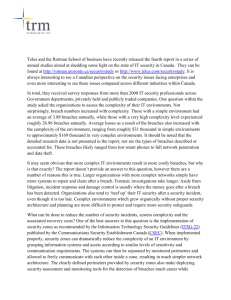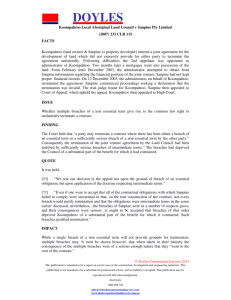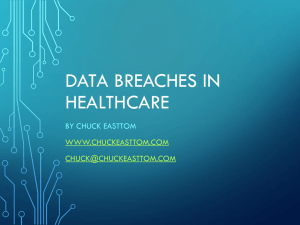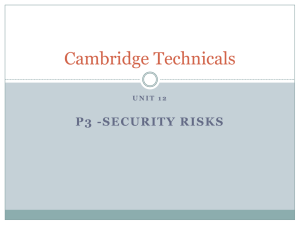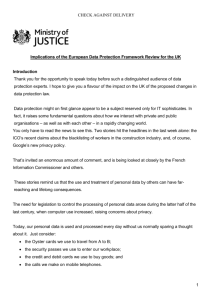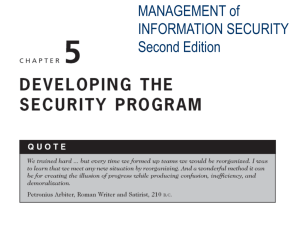2009 National Cyber Security Symposium
advertisement
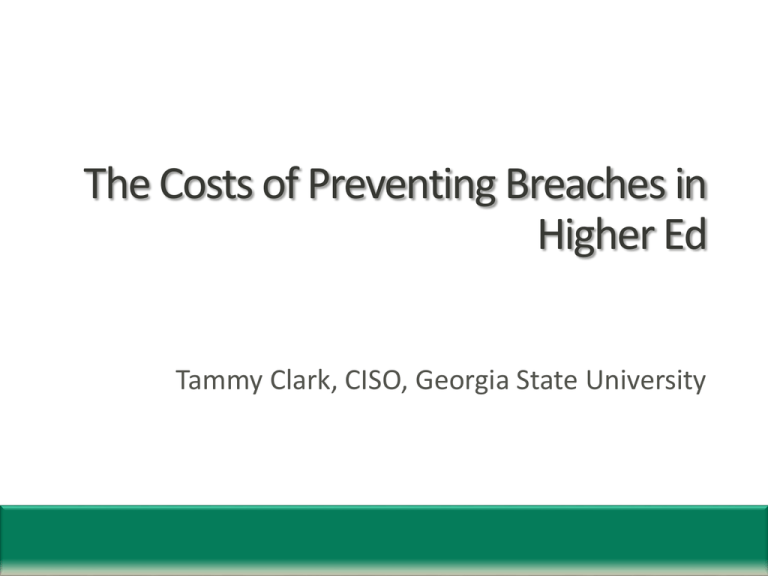
The Costs of Preventing Breaches in Higher Ed Tammy Clark, CISO, Georgia State University Introducing… I was a very persistent Hacker Whacker—Doing battle with Hackers in the early years of our information security program. It was a thankless job, but someone had to do it… Key Topics For Today’s Discussion Today’s Threat Landscape Breaches and Root Causes What Seems to Be the Problem Here?! What Drives Change in Higher Ed? Can We Use Technology, Processes, and People Effectively to Assist with Breach Prevention? The ‘Nitty-Gritty’ About Our Information Security Programs Summary of Key Points Join in On the Fun With Questions or Comments Today’s Threat Landscape What are the prevalent threats we’re seeing out there that affect our end users? Lots of spear phishing Infected websites Social Engineering, Scams, Organized Crime Our IT orgs are dealing with increasingly sophisticated malware, SSH attacks and OS/APP vulnerabilities. New exploits continue to be developed at a dizzying pace and our vendors can’t seem to keep up! Breaches and Root Causes Educational Security Incidents (ESI) reports that in 2008: 173 separate incidents were reported 24.5% increase over 2007 Primary Reasons: Unauthorized Disclosure - 75 Theft - 40 Unauthorized Access/Penetration – 35 Additionally, Privacy Rights Clearinghouse reports that so far in 2009, 38 colleges have reported incidents out of 196 total incidents reported… Of these, 17 were due to theft; 11 to unauthorized access/penetration, and 10 were the result of unauthorized disclosure What Seems to Be the Problem Here!? Lack of standardization/plans, policies and standards Challenges in data classification and risk management Incorrectly configured/secured devices, apps and Web sites Inadequate perimeter protection Lack of advanced intrusion detection & analysis skills Inadequate endpoint protection Lack of encryption Open ended culture Security ‘un-aware’ users—no ‘skin in the game’ or circumventing controls What Drives Change in Higher Ed? Let’s face it--data breaches (either our own or a neighboring institution) Compliance: PCI, FERPA, HIPAA, GLBA, Red Flags, DMCA Research grants that require minimum levels of security or compliance with FISMA or ISO 27001/2 Budget cuts Audits Emergency management Risk management University president’s/provost’s priorities Can We Use Technology to Assist with Preventing Breaches? Network intrusion prevention, intrusion detection, firewalls, AV and anti-spam gateways, et al) Endpoint security tools and suites (AV, anti-spyware, antimalware, host firewalls/IPS, NAC, etc) Encryption Vulnerability assessments Governance, risk and compliance Data loss prevention Identity access management Security information and event management The list goes on…and on Bottom Line---$$$$$$$$$$$$$$$$$$$$$$$$$$$$ Is Process Development Important as Well? YES! Why? Myriad of compliance requirements Standards (ISO, FISMA, COBIT, ITIL) and standardization (yes! in higher ed.) Get rid of confidential data we don’t need or require! Data classification and risk management Audits/corrective & preventive measures Physical & logical controls to integrate into IT/business processes 3rd parties processing or storing our data Contracts with customers on campus to manage their critical systems and data with central IT/Sec organizations And What About the People?! Authority (must) = Accountability (the golden rule) Make IT system/data protection everyone’s job! Responsible for compliance – in some cases, personal liability Data cleanup parties including non-electronic formats Security reviews and mandated controls for systems processing confidential data (require encryption, not running P2P apps, etc.) Lots and lots of security awareness training! Higher Ed Information Security Programs—The ‘Nitty-Gritty’ Reactive Proactive Predictive Reactive People – Depend on ‘security unaware’ end users and (often) a cheerleader ISO! Process – Too busy chasing the threats and incidents! Technology – Protecting either the outside perimeter or workstations/servers (AV, firewalls) $$$ Investment in breach prevention - Low Aftermath of a potential breach – High impact Information security program maturity index – 1 or 2 on the CMMI Largest impacts to information security programs in reactive mode - Lots of unfunded mandates, inadequate resources and funding, threat of penalties/lawsuits due to noncompliance and lack of due diligence, difficulty detecting and responding to security incidents, increased reputational risk, high risk of widespread malware outbreaks and data breaches Proactive People – Emphasis on securing adequate resources Process – Huge investment in process development and awareness training Technology – Implement defense in depth architecture $$$ Investment in breach prevention – Very high Aftermath of a potential breach – Medium impact Information security program maturity index – 3 or 4 on the CMMI Largest impacts to information security programs in proactive stage/mode – Heavy infrastructure costs; resource intensive activities; paradigm shifts towards incorporating standards and regulatory guidance; increased standardization, risk management, and attention to building out a fully functional information security program; heavy reliance by the IT org. on the information security dept. staff to protect institutional data/IT resources Predictive People – Emphasis on integrating information security throughout the IT org and university Process – Continuing investment; increased emphasis on security awareness education and training Technology –Emphasis on optimizing technology investment $$$ investment in breach prevention –Spread and streamline costs as IS integrates throughout the IT org and campus Aftermath of a potential breach – Low impact Information security program maturity index – 4 or 5 on the CMMI Largest impacts to information security programs in predictive stage/mode – no information security silos, information security is integrated into every facet of the institution, data protection is everyone’s responsibility, authority=accountability, dedicated staff focus on core IS duties Case Study—Infosec@Ga State Univ 2000-2003: Reactive Mode 2004-2009: Proactive Mode 2010: Moving into Predictive Mode Infosec@Ga State Univ The early years—reactive mode One dedicated information security staff member— CISO Tiny budget for information security--$40k first year to buy tools, equipment, training 75% of CISO time – incident response Widespread malware outbreaks occurred 3-4 times Primary tech solutions—IDS at perimeter; AV/firewalls on desktops & servers Very little process development Infosec@Ga State Univ Ramping up the information security program— moving into proactive mode Additional staff members to specialize in various areas of infosec (technical, people and process) Large budget increase to accommodate program initiatives (over $200k per year) Over 75% CISO time spent on policy/process development and security awareness training 25% staff time on incident response No widespread malware outbreaks Tech solutions emphasized defense in depth Security incident reductions of over 98% Huge emphasis on governance, risk and compliance Achieved ISO 27001 certification for 2 areas of univ. Infosec@Ga State Univ Shifting gears into predictive mode Significant re-org. of IT/security resulted in security ops & engineering moving into IT org. and CISO, and one dedicated staff member maintaining the Infosec Office at GSU Authority=Accountability, as system owners and data stewards are accountable for security Information security budget pieces devoted to solutions/engineering and operations moved to those particular IT groups Security architecture is being ramped up to incorporate integrated vendor solutions that offer predictive capabilities, as well as heavy automation to facilitate ops (infancy stage) Over 85% CISO time spent on policy/process development and security awareness training 25% staff time on incident investigations; 75% risk mgt., sec. reviews, vuln. assessments, forensics Summary of Key Points Threats continue to heavily target end users Human errors account for over 70% of data breaches that occur Information security staffs should not be held accountable for protecting institutional assets and data Information security needs to be integrated throughout our IT organizations and campuses In order to mature and ensure continuous improvement, information security programs must be adequately funded and ramped up in terms of people, process and technology Effective policies, processes, guidelines and security training/education must be emphasized and funded in terms of $$ and resources Building a solid community of ‘security aware’ users represents both our greatest challenge and our best defense against data breaches! Questions? Contact Tammy Clark at tlclark@gsu.edu, 404 413 4509 Copyright Tammy L. Clark, Oct 2009.. This work is the intellectual property of the author. Permission is granted for this material to be shared for non-commercial, educational purposes, provided that this copyright statement appears on the reproduced materials and notice is given that the copying is by permission of the author. To disseminate otherwise or to republish requires written permission from the author.

